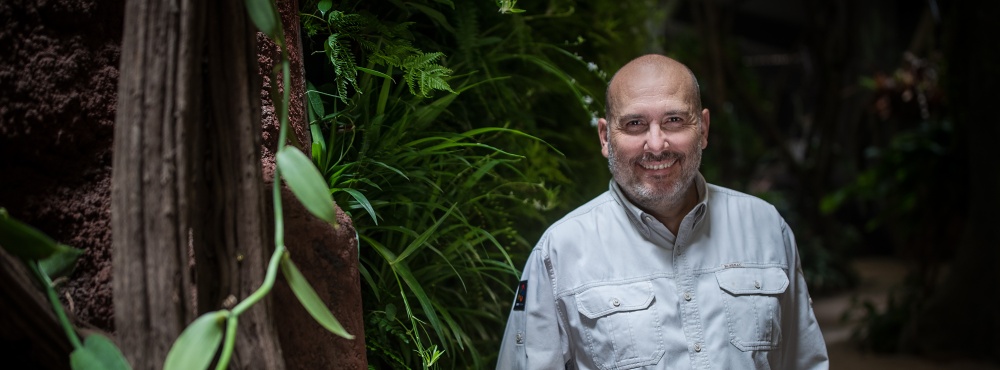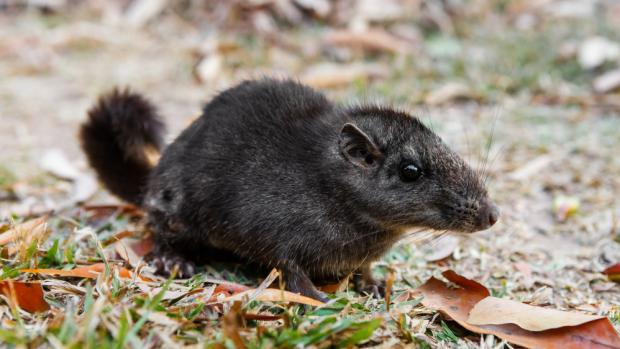Following the Mysterious kha-nyou

After a several hours long journey from the Laotian capital Vientiane, we briefly dropped off our stuff at the hotel and, led by French naturalist Jean-Pierre Hugot, set off to the local market. I did not have any high hopes of discovering anything special there, but I wanted to see it at least. Twenty years ago American zoologist Rob Timmins discovered just here a so far unknown animal, called by local people kha-nyou [kanyu]. And because of it we arrived to Laos, and Thakhek.
 Mysterious, unique and endangered kha-nyou. Its Czech name Laoš is an acronym of Laos mouse. Photo: Miroslav Bobek
Mysterious, unique and endangered kha-nyou. Its Czech name Laoš is an acronym of Laos mouse. Photo: Miroslav Bobek
Jean-Pierre led us through the entrails of the market, until we came upon the women selling "bushmeat". They had frogs, plucked chicks of many bird species as well as adult barbets and bluebirds, and of course also rats and squirrels. Our colleagues Pavel Brandl and Radoslaw Ratajszczak were quickly identifying individual animals, only they could not cope with one red-black squirrel. Later they discovered that it was a subspecies, only recently discovered and still waiting for its scientific description.
We passed several other women when suddenly I spotted among "bushmeat" the dead bodies of four black animals with fury, squirrel-like tails. The women immediately hid them from me, but there were no doubts. I would never believe it, but shortly after arriving to Thakhek we came across an animal which was unknown to science until 1996 and which was photographed alive only in 2006. These four black animals were kha-nyou. They are also known as cat-rats, rat-squirrels or Laos rock rats, scientifically representatives of Laonastes aenigmamus species.
After Rob Timmins discovered the first specimen of kha-nyou, a commotion broke out. No one had ever seen such a strange rodent. It looked like it had the head of a porcupine, the body of a rat and the tail of a squirrel. It was, furthermore, carrying a lot of ancient features. It was classified in a new family and introducing a new family within mammals, it is a sensation which rarely happens. Moreover, later it became clear that very similar rodents were described based on paleontological findings; but these were supposed to have become extinct 11 billion year ago. So kha-nyou became Lazarus taxon, which highlighted its importance even more. In spite of that it took all of eleven years before the world could see photographs and a video of a live specimen. These were taken by the 74-year-old retired American and amateur ornithologist David Redfield, who travelled to Laos with this goal and had hired local hunters to catch one kha-nyou alive for him.
We did not believe that during our journey to Laos we would see at least one dead kha-nyou, but the finding at the Thakhek market woke up our hope and ambitions. The next morning we left Thakhek for the countryside, again led by the experienced Jean-Pierre. The landscape of Khammouan Province, where Thakhek is the capital, is really extraordinary, and not only because during the last 25 years many unknown or for decades unseen animals were discovered here. Very soon we reached towering ridges and hummocks of the local karst area, which is one of the most important biodiversity hotspots on our planet. Where and how can kha-nyou live here?, we were guessing. It even remains unknown to the present day whether it is a daytime or nocturnal animal.
After a half an hour drive we stopped at some food stalls. Just a few questions… and we learned that in the fridge there are kha-nyous for sale among Fantas, Coca-Colas and bottled water. A suspicion started to germinate that they are hunted in large numbers, which could - regarding the limited area of its distribution, where the density of population is rapidly increasing - lead them to being soon critically endangered, if not extinct. And our suspicion grew even stronger when we arrived at the market in Ban Khok Sawan village. The local offer of "bushmenat" was much wider than in Thakhek and kha-yous were not missing.
We travelled to Laos on the initiative of the team of EAZA (European Association of Zoos and Aquaria) focused on small mammals, which concluded, that regarding the possible threat to kha-nyou, it is necessary to try to breed it in captivity. At the same time the experience we gained in one single day demonstrated that its situation is probably much worse than anyone in Europe could have expected.
However, Ban Khok Sawan brough us joy as well. One of the local people had at home an alive kha-nyou, perhaps to keep away mice and rats from his house built on stills or just as a pet. He brought it outside and let it run among stones and dry clumps of grass. I have never seen a similar animal! Kha-nyou did not show a single sign of shyness, deliberately walking here and there looking for something to eat. It differed unbelievably from the first drawing made by Rob Timmins twenty years ago, which spread throughout the world. Rob caught an emaciated little animal with a pulled tail - but we had in front of us shiny black "squirrel" with convex facial profile, which looked nicer than Chip and Dale all together.
It was a great ending to the first phase of our journey in search of kha-nyou and, at the same time, the first step on a long journey, which should lead to the protection of this extraordinary and mysterious creature - and hopefully also to us being able to show it to visitors of our zoos.
Miroslav Bobek
Director, Prague Zoo
ZOOPRAHA.CZ
Contacts
- The Prague zoological garden
U Trojskeho zamku 120/3
171 00 Praha 7
Phone.: (+420) 296 112 230 (public relations department)
e-mail: zoopraha@zoopraha.cz
Others











